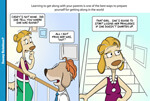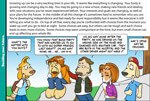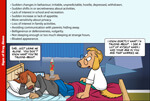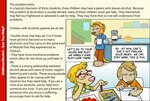- Home
- Comics
-
For Parents
Parent's Comics
Parents Resources
-
Resources
Drug Facts Forums
Drug Facts News
Other Resources
-
Connect
Everyone
Parkinson’s breakthrough changes what we know about dopamine
A new study shows dopamine isn’t the brain’s movement “gas pedal” after all. Instead of setting speed or strength, it quietly enables movement in the background, much like oil in an engine. When scientists manipulated dopamine during movement, nothing changed—but restoring baseline dopamine levels made a big difference. The finding could reshape how Parkinson’s disease is treated.
Categories: Drug Facts
Young adults are using cannabis to sleep at alarming rates
More than 20% of young adults say they use cannabis or alcohol to fall asleep, with cannabis leading by a wide margin. Researchers warn this strategy can backfire, disrupting sleep quality and increasing the risk of long-term sleep and substance-use problems.
Categories: Drug Facts
Cannabis compounds show unexpected power against ovarian cancer
Scientists have discovered that key compounds from cannabis—CBD and THC—show surprisingly strong effects against ovarian cancer cells. Used together, they slow cell growth, reduce colony formation, and may even block the cancer’s ability to spread. Even more promising, the treatment caused minimal harm to healthy cells and appears to work by restoring a disrupted signaling pathway that fuels tumor growth.
Categories: Drug Facts
The brain switch that could rewrite how we treat mental illness
Scientists exploring how the brain responds to stress discovered molecular changes that can influence behavior long after an experience ends. They also identified natural resilience systems that help protect certain individuals from harm. These findings are opening the door to treatments that focus on building strength, not just correcting problems. The work is also fueling a broader effort to keep science open, independent, and accessible.
Categories: Drug Facts
Scientists reveal the real benefits and hidden risks of medical cannabis
A sweeping review of more than 2,500 studies reveals that despite booming public enthusiasm, cannabis has strong scientific support for only a few medical uses, leaving most popular claims—like relief for chronic pain, anxiety, and insomnia—on shaky ground. The findings spotlight a persistent gap between what people believe cannabis can do and what clinical evidence actually shows.
Categories: Drug Facts
Stressed rats keep returning to cannabis and scientists know why
Rats with naturally high stress levels were far more likely to self-administer cannabis when given access. Behavioral testing showed that baseline stress hormones were the strongest predictor of cannabis-seeking behavior. Lower cognitive flexibility and low endocannabinoid levels also contributed to increased use. The results hint at possible early indicators of vulnerability to drug misuse.
Categories: Drug Facts
Garlic mouthwash shows shockingly strong germ-fighting power
Garlic extract is emerging as a surprisingly powerful contender to chlorhexidine, the long-standing “gold standard” in antimicrobial mouthwashes. A systematic review of clinical studies shows that higher-concentration garlic mouthwash can rival chlorhexidine in killing bacteria—sometimes outperforming it—while offering a more natural alternative.
Categories: Drug Facts
Millions are about to choose the wrong Medicare plan
Millions face Medicare decisions each year, but many don’t take advantage of tools that can save them money and stress. Insurance marketing often overshadows unbiased options like SHIP, leaving people unaware of better choices. Comparing real costs—not just premiums—can prevent unpleasant surprises, especially when provider networks or drug rules change. New assistance programs for low-income adults offer valuable help for 2026.
Categories: Drug Facts
Where cannabis stores cluster, emergency visits climb
Researchers analyzed data from over six million people to see how close residents lived to cannabis retailers. Neighborhoods near these shops experienced higher cannabis-related emergency visits compared with those farther away. The effect was strongest where multiple stores were packed into small areas. These trends suggest that store density plays a meaningful role in community health.
Categories: Drug Facts
Scientists studied 47,000 dogs on CBD and found a surprising behavior shift
Data from over 47,000 dogs reveal that CBD is most often used in older pets with chronic health issues. Long-term CBD use was linked to reduced aggression, though other anxious behaviors didn’t improve. The trend was strongest among dogs whose owners lived in cannabis-friendly states.
Categories: Drug Facts
Why more cannabis users are landing in the ER with severe vomiting
Chronic cannabis use is increasingly linked to recurring bouts of vomiting, now officially classified as cannabis hyperemesis syndrome. The new ICD code helps doctors identify cases more consistently and gives researchers a clearer picture of how often it occurs. Patients often resist the diagnosis, and the condition’s causes remain murky. Relief can come from unusual sources like hot showers or capsaicin cream.
Categories: Drug Facts
Scientists reveal a hidden hormone switch for learning
Researchers uncovered how estrogen subtly reshapes learning by strengthening dopamine reward signals in the brain. Rats learned faster when estrogen levels were high and struggled when the hormone’s activity was blocked. The findings help explain how hormonal cycles influence cognitive performance and psychiatric symptoms. This connection offers a new path for understanding brain disorders tied to dopamine.
Categories: Drug Facts
How to keep Ozempic/Wegovy weight loss without the nausea
Scientists are uncovering how GLP-1 drugs like Ozempic and Wegovy act on brain regions that control hunger, nausea, pleasure-based eating, and thirst. These discoveries may help create treatments that keep the benefits of weight loss while reducing unwanted side effects.
Categories: Drug Facts
Blocking one enzyme may break the link between alcohol and liver disease
Scientists discovered that alcohol activates a sugar-producing pathway in the body, creating fructose that may reinforce addictive drinking. The enzyme responsible, KHK, appears to drive both alcohol cravings and liver injury. When this enzyme was blocked in mice, their drinking decreased and their livers showed far less damage.
Categories: Drug Facts
A surprising CBD advance calms pain without side effects
Researchers developed a new nano-micelle formulation, CBD-IN, that finally gets CBD into the brain effectively. In mice, it relieved neuropathic pain quickly and didn’t cause the usual movement or memory side effects. Surprisingly, the pain relief didn’t use typical cannabinoid receptors, instead calming abnormal nerve activity more directly. The findings hint at new avenues for treating chronic pain and neurological diseases.
Categories: Drug Facts
Smoking cannabis with tobacco may disrupt the brain’s “bliss molecule”
Scientists found that people who use both cannabis and tobacco show a distinct brain pattern tied to mood and stress regulation. Their scans revealed higher levels of an enzyme that reduces a natural feel-good molecule in the brain. This imbalance may help explain why co-users experience more anxiety and struggle more when quitting.
Categories: Drug Facts
The bright colors in your food may be harming your kids
Almost 20% of packaged foods and beverages in the US contain synthetic dyes, often paired with excessive sugar to attract children. These additives have been linked to behavioral issues, yet remain widespread among major brands like Mars and PepsiCo. Experts criticize the FDA for relying on voluntary reform, contrasting it with Europe’s stricter labeling laws. Growing state-level action offers hope for meaningful change.
Categories: Drug Facts
Breakthrough brain discovery reveals a natural way to relieve pain
Using powerful 7-Tesla brain imaging, researchers mapped how the brainstem manages pain differently across the body. They discovered that distinct regions activate for facial versus limb pain, showing the brain’s built-in precision pain control system. The findings could lead to targeted, non-opioid treatments that use cannabinoid mechanisms instead of opioids, offering safer pain relief options.
Categories: Drug Facts
Scientists discover a surprising way to quiet the anxious mind
Generalized anxiety disorder affects millions, often trapping sufferers in cycles of fear and isolation that conventional medications barely relieve. At UCSF, neuroscientist Jennifer Mitchell is testing a pharmaceutical form of LSD called MM120, which has shown striking results in reducing symptoms by promoting neuroplasticity and easing rigid thought patterns. In clinical trials, a single dose significantly outperformed standard treatments, offering hope to those who have found little relief elsewhere.
Categories: Drug Facts
Weight-loss drugs like Ozempic may also curb drug and alcohol addiction
GLP-1 drugs, originally developed for diabetes and obesity, may also curb addictive behaviors by acting on reward circuits in the brain. Early trials show reductions in alcohol intake, opioid seeking, and nicotine use. Though more research is needed, scientists believe these drugs could open a powerful new front in addiction therapy.
Categories: Drug Facts









